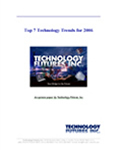TFI Once Again Ushers in the New Year with a Special Trend Paper

Top 7 Technology Trends for 2006
Technology Futures, Inc.
Once again, Technology Futures, Inc. (TFI) provides important emerging technology trends for 2006 and beyond developed through our 27 years of forecasting, strategy, and analysis work. We see these trends as great consequence to those involved with global business, technology business process, science and universities, government agencies, federal labs, corporate labs, and technology savvy consumers. Comparing this year's trends to TFI's list of trends for 2005, we see the trends as being still on the mark, with continuing progress being made in all the areas outlined last year. Below we have outlined some of the developments and provide some new trends and enhancements.
Top 7 Technology Trends for 2006:
-
Traditional media continues to change as the impact of the democratization of the Internet and the increased penetration of global broadband coverage expands the Internet even more.
As we noted last year, Broadband and high-speed wireless penetration reach a large enough market for new classes of applications to emerge. These new products will explicitly take advantage of what broadband and wireless networks have to offer in terms of mobility and accessibility to the global marketplace. Location-based services is one class of service that will emerge. The impact of VoIP extends beyond the business users and will become common place in the new digital home. 2006 will see the first impact of mobile VoIP in connected devices.
-
The threat to security and privacy continues to grow and to expand to other devices besides the wired Internet such as mobile devices and device-to-device networks.
Last year we talked about the dramatic escalation in device-to-device communication versus people-to-people communication. This trend continues, and the increasing threats to security and privacy also increase in tandem.
-
The digital home is entering the next level of acceptance, with the expansion of the electronic gaming and MP3 marketplace being a major driver.
High definition TV and digital recording at home are important drivers, but increasingly a major driver of the digital home is the electronic gaming and MP3 marketplace. The devices have become more than just a video game or a portable audio experience, with integration into many different devices and vehicles, and the addition of video to the MP3 devices. One of the next phases of growth is that of individual content creation. This do-it-yourself (DIY) content creation will vastly expand on P2P networks and will ride on the back of expanding computing power, storage expansion, broadband penetration, and Reeds law of community building. The power of the games will expand beyond PCs and game consoles to many other forms and devices. On-demand gaming will become part of many households. IPTV will see a new acceptance and because of both broadband penetration and new business models become part of many households.
-
Public relations and marketing expenditures and projects continue their shift to the public networks.
Not only the Internet, but wireless and cellular networks and the new smart, location aware devices will play an increasingly important role in the transition to public networks. The usage and proliferation of mobile commerce keeps expanding.
-
The timeframe of the product life-cycle continues to decrease.
In a continuation of the trend from last year, by the time a product hits the market, its shelf life is half what it used to be. So, to remain competitive, science and research time will become more intensive and innovative earlier as product development time continues to compress at an unprecedented rate. Innovation and a future focus will be necessary to remain in the game. Technologies such as grid technology, mid-weight computer clients, and collaborative computing play large roles in making every device a server.
-
Globalization and outsourcing continue to be paradigms of success.
Again, as in last year, to be successful in a real-time, global marketplace, businesses must understand and adapt to the new source of competitive advantage by connecting to the core competencies and customer interaction on a global scale. In the business world, global collaboration is imperative. Outsourcing becomes more strategic--it's not all about price.
-
The age of bio enters a new stage of production as advances in the technology continue.
Continuing the trend from 2005, national and global collaboration is enhancing potential bio commercialization. Bio is beginning to see a pay-off in 2006, and the first wave of consolidation takes place.
TFI excels at relating emerging trends to the specific interests of clients and providing a future-focused analysis of what developments and opportunities can be expected in the near and more distant future in a particular industry or organization. If you believe TFI can be of assistance to you in this area, please contact us at (512) 258-8898 or (800) TEK-FUTR, or by e-mail at info@tfi.com. We welcome your inquiries.

